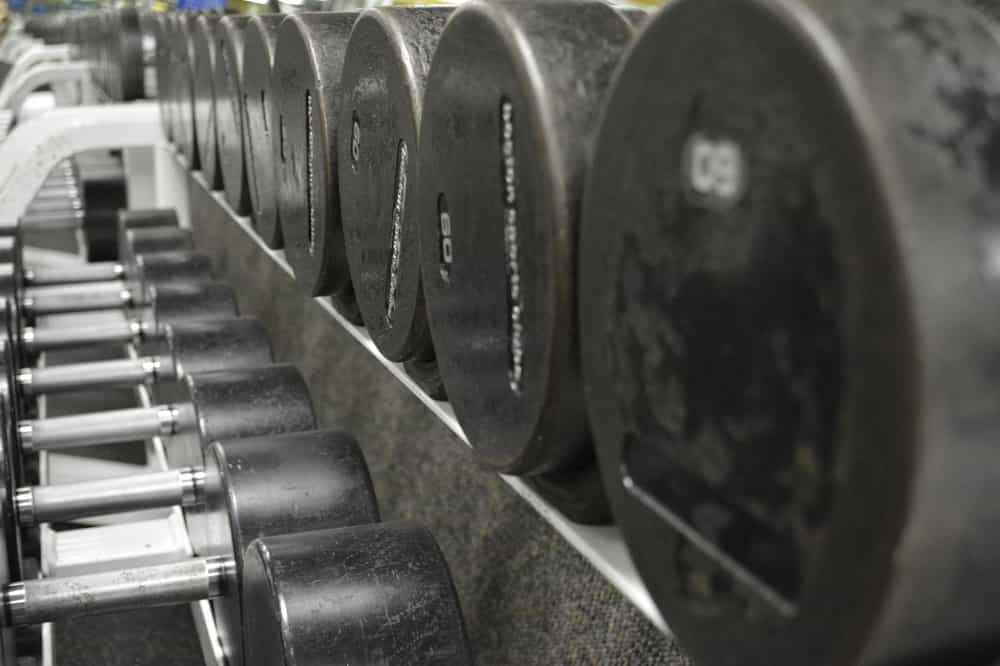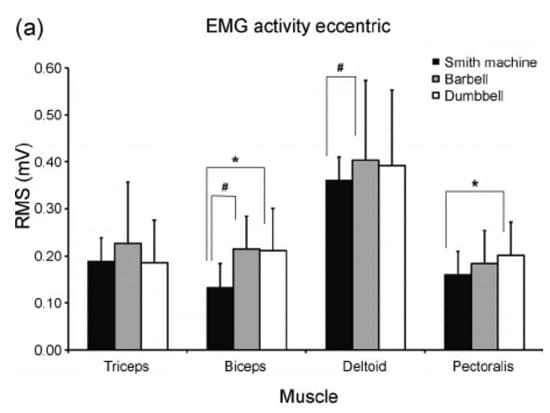Here is everything you need to know about why you should be using the dumbbell bench press in order to get a stronger and get more muscular chest and upper body.

In this little guide, we will go over the benefits of the dumbbell bench press, how to master the lift to insure superior performance, and how in many ways it is a much better option for lifters compared to the classic barbell bench press.
The reality is that dumbbells are much more versatile, and in many instances, are a safer alternative to the barbell bench.
But before we launch into a list of reasons why the dumbbell bench press rocks, consider that it’s only truly better for you if it matches up to what you are trying to achieve iduring your workout routine.
“Are you looking to complete a task that requires you to push one solid object evenly with both hands?” says Melissa Reh, CSCS and Licensed Physical Therapist at Grayslake, Illinois-based Kinesi.
“In that case a barbell bench press might be right for you. Do you want to be able to move your arms independently from each other, with varied hand positions, or in multiple different directions? If so, a dumbbell bench press will likely serve you better.”
- See also: Looking for dumbbells for your home gym? Here is a breakdown of the 7 best dumbbells for working out at home.
The dumbbell bench press is only better for you if it better serves what you are trying to do in the gym and outside of it. Got it? Good.
Now, with that out of the way, here are a few reasons that the dumbbell bench might be what you need to attain bench press glory and awesomeness:
1. It opens up the glaring discrepancies in muscular imbalances.
Muscle imbalances are inevitable for almost all of us. We are going to be dominant on one side of the body whether it’s because we are a righty or on the rarer side of things, a lefty.
With the barbell you can mask these imbalances by overcompensating with your strong side to make up for the other. You see it all the time with lifters who push one side of the bar up faster than the other.
“A key benefit of using dumbbells is having the ability to isolate and identify unilateral deficiencies within the chest and shoulder,” says Stan Rotay, CSCS and bossman at ONEup Performance.
When your limbs are forced to work on their own it becomes a lot harder to ingest some humble pie and accept that you might have to do some work on correcting muscle imbalances.
“The dumbbell bench press is the perfect tool for identifying imbalances in the deltoids, pectorals, and trapezius,” adds George Paul Scheppler, US Navy vet, Tactical Strength and Conditioning Facilitator, and head coach at Apex Predator Athletics in Marina, California.
“Unlike with the traditional bench press you can not mask the inability to maintain a smooth symmetrical lowering and pressing of the dumbbells, making the dumbbell bench a great tool for both coaches and athletes alike.”
And the first step to correcting those imbalances is to have the self-awareness necessary to recognize them.
2. You can assume a more natural, more neutral grip.
Perhaps most noticeably for those who have had shoulder issues in the past (author included), is that using dumbbells allows for a more natural grip, giving the wrists and elbows a little flexibility of movement that is impossible with the bar.
Additionally, and again this is purely in the author’s experience, having that flexibility allows the elbows to flare more naturally outwards.
- See also: Rubber hex dumbbells are one of my favorite additions to my home gym. Here is a full rundown of the best rubber hex dumbbells for your home or garage gym.
The versatility of the dumbbell comes into play here again as you can go fully neutral with your grip (palms facing each other as you grip the dumbbells), and with elbows tucked in emphasize the triceps, offering you an alternative to the close grip standard barbell bench.
3. You can go single-arm and blast away at your core.
It’s odd, isn’t it—we have no qualms about performing single leg variations of our best lower body exercises, but when it comes to the upper body everything seems to have to roll in pairs.
Throw in some dumbbells, however, and we get some options, one of which includes hammering away at your core when doing single arm dumbbell bench press.
How do I know this?
Because if you don’t engage your core like a son of a gun you will roll right off of the side of the bench.
“For athletes in particular, using one dumbbell at a time, with your non-working hand not holding anything allows for great core strengthening on top of the chest work,” says David Kim, CSCS, who provides online and personal coaching with DK Athletic Performance.
“Holding a weight only on one side will challenge your anti-rotational strength significantly, which is an important function of many athletic movements.”
If you have never tried this before don’t be embarrassed to decrease the weight a bit on your initial go around—the first time you lower the dumbbell you’ll find your body tightening up big time in order to keep itself from tipping off the bench.
Remember to keep your butt firmly on the bench, your feet planted (don’t dance them around), and keep your body steady and rigid on the bench throughout the movement.
4. Safer.
Unlike the barbell bench, once your muscles tap out, you can fail relatively safely drop the weights.
For those who want to push themselves to the point of failure, but don’t have the option of a spotter, dumbbells are where it is at.
“Typically you’ll be doing less weight with dumbbells because of that increased freedom of movement,” says Rob Dulabon, B.Sc., CSCS, founder and head trainer at Pittsburgh-based Rodu Training.
“And if you fail a rep without a spotter, bailing is much easier and safer with dumbbells over a barbell.”
Safety first, kids.
5. Forces you to be a little more honest about the lift.
Although you will have to come down a little bit in weight with dumbbells, you’ll find that you are training the muscle more so with dumbbells than the bench press movement.
After all, you lose some of the leg driving that is inherent in a good bench, and the back arching that shortens the lift, again, you end up training the muscles and not so much the movement.
6. You get all the muscle activation benefits of barbell bench.
Most importantly for those who hit the bench purely to get jacked, the muscle activation in the chest—the target muscle—is no different than doing bench with a barbell.
In research done with college age participants motor unit activation was the same between dumbbell bench, barbell bench, and dumbbell flys.
The amount of time the target muscles—the pectoralis major and anterior deltoid—were activated was also not statistically significant between the DB and BB bench, whereas the dumbbell fly lagged, relegating it to a secondary lift in terms of muscle activation.
In other words, when it comes to stimulating your chesticles, whether you use the DB or the BB doesn’t really matter.
7. And the added recruitment of your biceps during the lift.
Want some more space science? Well, buckle in then!
In a study that aimed to find the difference in muscle recruitment between the dumbbell bench, barbell bench and the Smith machine, EMG activity in the biceps branchii was highest when the test benchers wielded dumbbells.
As it turned out, the stability requirements each lift required increased as more stability was required, with bicep EMG activity increasing from Smith to barbell to dumbbell.

(Note that tricep recruitment was lowest with the dumbbell bench press, something to remember if your goal is to improve the lock-out phase of your bench.)
8. Get your benching in without having to wade into the ‘Test Nest.’
For people just getting into the gym, the dumbbell bench is a great way to ease into the world of weight lifting without wading in the always congested bench area.
The barbell benches are always a hive of activity at local gyms, whether it is a Monday (“International Chest Day”), or any other time of the week, really.
See also: 7 Dumbbell Back Exercises (Plus Benefits and a 20-Minute Back Workout)
The air is usually thick with testosterone and unrelenting Bro-science, and as such can be a little intimidating for someone who is a little more modest about their lifting goals than someone who has bumper plates lined up at the base of the rack like a deck of cards and two spotters on hand.
The flexibility that dumbbells gives you means that you don’t even need a bench—you can always slide up on a swiss ball or even the floor for some floor presses.
9. Larger range of motion.
With the freedom of the dumbbell comes the possibility that you can hit a fuller range of motion with the lift in comparison to the barbell.
“This could theoretically result in more growth of the chest due to greater mechanical tension and muscular damage as a result of the deeper weighed stretch,” notes David Larson, CSCS, MS, head trainer with Larson Fitness and also a Kinesiology Faculty Associate at Arizona State University.
The different range of motion can also help lifters skirt around stubborn training plateaus:
“Switching from a BBP to a DBP could help to overcome plateaus simply from the novelty factor involved in the altered neuromuscular recruitment patterns,” adds Larson.
In Summary
The decision with whether to go with dumbbells or the barbell for the bench press is ultimately up to you and what you want to achieve in the gym.
Its versatility aside, at the end of the day using DB’s should match up and serve what you are trying to accomplish in the weight room.
“It depends. It always depends,” adds Reh.
“As with any exercise, both your personal threshold (what you can comfortably and safely do) and your functional goal (what you want to be able to do well) should be considered.”
More Bench Press Resources:
- 17 Ways to Increase Your Bench Press. While this guide applies more to the barbell bench press, there is still a wealth of knowledge here that applies to dumbbell bench as well. (And really, you should be reaping the benefits of both by mixing it up.)
- 3 Fundamentals of a Powerful Bench Press. Want to develop a bench that is not only heavy, but also high in power? These three basics of powerhouse bench pressing should form the foundation of your training program moving forward.